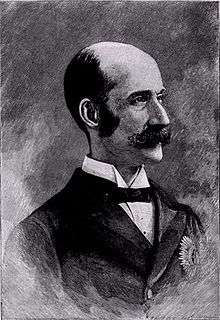Lansdowne Letter
The "Lansdowne Letter" was a letter to a London newspaper written by Henry Petty-Fitzmaurice, 5th Marquess of Lansdowne, which called for Britain to negotiate a peace with Imperial Germany during the First World War. Lansdowne had been the minister for war and for foreign affairs, but this time he came under withering criticism with few supporters.

Background
In November 1916 Lansdowne circulated a paper to the Cabinet, in which he argued that the war would destroy civilisation and that therefore peace should be negotiated on the basis of the status quo ante bellum.[1] Lansdowne's proposal received a hostile response from other Unionists in the Cabinet such as Arthur Balfour and Robert Cecil.[2]
Lansdowne invited the editor of The Times, Geoffrey Dawson, to his house and showed him the letter he wanted to publish. Dawson was "appalled" and decided that publication would not be in the national interest.[3] Lansdowne also showed the text to the Foreign Office who did not veto it. He then offered the letter to The Daily Telegraph, which accepted it.
Publication
On 29 November 1917 Lansdowne's letter was published in The Daily Telegraph. It again called for a negotiated peace with Germany:
We are not going to lose this war, but its prolongation will spell ruin for the civilised world, and an infinite addition to the load of human suffering which already weighs upon it...We do not desire the annihilation of Germany as a great power ... We do not seek to impose upon her people any form of government other than that of their own choice... We have no desire to deny Germany her place among the great commercial communities of the world.[4]
The letter also called for a guarantee of the 'freedom of the seas'.
Reaction
Lansdowne became a pariah and his letter "a deed of shame".[3] Bonar Law publicly criticised Lansdowne's letter although U.S. President Woodrow Wilson was said to be "impressed" by the letter's arguments. H. G. Wells said Lansdowne's letter "was the letter of a Peer who fears revolution more than national dishonour".[5]
Military leaders dismissed Lansdowne's proposals. Douglas Haig said that the prospects for 1918 were "excellent". Sir William Robertson, when asked whether the war could be won, replied:
Quite frankly, and at the same time quite respectfully, I can only say I am surprised that the question should be asked. The idea had not before entered my head that any member of His Majesty's Government had a doubt on the matter.[6]
Most of the British press were critical of Lansdowne's proposals. The Times attacked it as did The Morning Post and The Daily Mail.[3] The Manchester Guardian and the Daily News welcomed the letter, as did the German press. In the United States, Theodore Roosevelt, the former American president and vocal proponent of the war effort, denounced the letter: "Such a peace would leave the liberty loving nations of mankind at the ultimate mercy of the triumphant militarism and capitalism of the German autocracy."[7]
The historian A.J.P. Taylor asserted that Fritz Fischer's work on German war aims revealed that the German government's minimum peace terms were incompatible with Lansdowne's proposals and that the Germans would have "rudely rejected" them.[8]
In February 1918 Lansdowne attempted to further advance bringing the war to a non-military conclusion by founding the Lansdowne Committee, and advocated them on the floor of the House of Lords.
Notes
- A. J. P. Taylor, English History 1914 - 1945 (Oxford University Press, 1990), p. 65.
- Taylor, p. 65.
- "Anthony Howard on ''The Westminster Hour''". BBC News. 2005-06-14. Retrieved 2010-05-02.
- "H.G. Wells, ''In the Fourth Year Anticipations of a World Peace'' (1918)". Infomotions.com. Archived from the original on 2011-09-29. Retrieved 2010-05-02.
- Taylor, p. 66.
- Roosevelt, Theodore (2 December 1917). "Colonel Roosevelt on the Lansdowne Letter". The Kansas City Star, 1; reprinted in Roosevelt in The Kansas City Star (Houghton Mifflin, 1921).
- Taylor, p. 65 and note.
Further reading
- Harold Kurtz, 'The Lansdowne Letter', History Today, 18 (1968), pp. 84–92.
- Douglas Newton, "The Lansdowne 'Peace Letter' of 1917 and the Prospect of Peace by Negotiation with Germany." Australian Journal of Politics & History 48.1 (2002): 16-39.<
External links
- Peace Initiatives at the International Encyclopedia of the First World War
- Text of the letter as republished in The New York Times